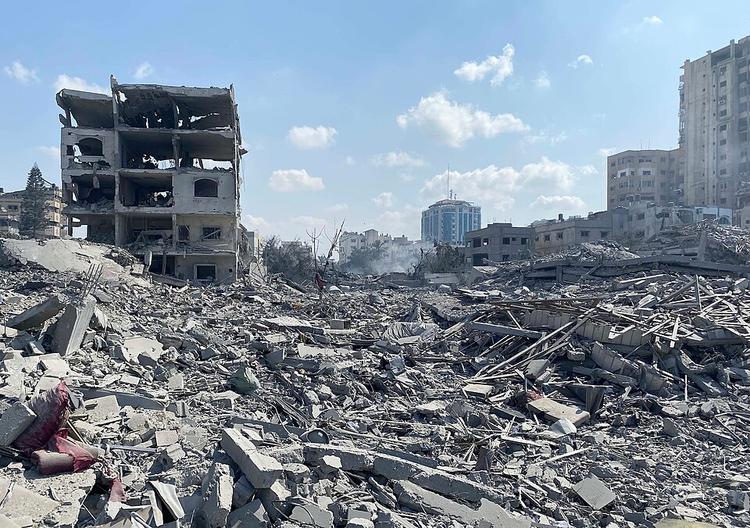By Masum Mahbub
( GlobalVoices.org ) – A ceasefire was finally signed. Humanitarian organizations are scaling up operations to reach families facing famine after nearly two years of relentless bombardment and blockade, and the world is turning its attention to rebuilding.
But the destruction of Gaza is not only a humanitarian tragedy. It has unleashed one of the most severe environmental disasters of the 21st century. Two years of nonstop bombardment have flattened neighborhoods, poisoned the soil, and contaminated the water and air. As the world moves to rebuild, we must understand that the challenge ahead is not simply humanitarian or political.
As the head of an organization that has worked for decades at the nexus of humanitarian emergency response and climate change, I have witnessed how environmental degradation can cripple a community. However, what we are seeing in Gaza is something else entirely. It is not simply the collateral damage of war; it is the deliberate, systematic destruction of an entire environment.
This is ecocide, waged as a weapon to make the land uninhabitable and render any future for a self-sufficient Palestinian society impossible.
Systematic destruction
Over the last decade, Palestinians in Gaza were making remarkable strides in climate resilience despite a suffocating blockade. Gaza had developed one of the highest densities of rooftop solar panels in the world, a grassroots solution to a manufactured energy crisis. They were implementing plans to manage scarce water and adapt to a warming climate. These efforts were a testament to their perseverance, but Israel’s military campaign has systematically erased this progress.
These are not random acts of war. The annihilation of nearly 70 percent of Gaza’s agricultural land, the razing of ancient olive groves, the obliteration of water pipelines, and the destruction of all five wastewater treatment plants are calculated blows against the very foundations of life.
When Israeli forces pump seawater into underground tunnels, they risk the permanent saline poisoning of Gaza’s only significant aquifer, the primary source of drinking water for over two million people. When bombs target rooftop solar arrays, they sever a lifeline of independent electricity for homes and hospitals.
Monumental carbon event
The environmental toll extends far beyond Gaza’s borders, creating a carbon “boot print” with global consequences. In the first 60 days alone, the conflict generated an estimated 281,000 metric tons of CO₂, more than the annual carbon footprint of over 20 of the world’s most climate-vulnerable nations combined.
Over 99 percent of these emissions are attributable to Israel’s aerial and ground operations. And the climate cost will continue long after the last bomb falls.
The reconstruction of Gaza is projected to be a monumental carbon event. Rebuilding the estimated 100,000 destroyed buildings could release an additional 30 million metric tons of CO₂, on par with the annual emissions of a country like New Zealand.
The unfolding famine in Gaza is a direct consequence of this environmental warfare. Starvation is not a byproduct of the conflict; it is a tool. When you destroy farms, annihilate 70 percent of the fishing fleet, and contaminate water sources with 130,000 cubic meters of raw sewage daily, you create famine. When you litter the landscape with 37 million tons of toxic rubble and unexploded ordnance, you make the land itself a threat to its inhabitants. The air is thick with pulverized concrete, asbestos, and heavy metals. With tens of thousands of bodies decomposing under the rubble, pathogens will continue to leach into the soil and groundwater for years.

Damage following an Israeli airstrike on the El-Remal area in Gaza City on October 9, 2023. WAFA. Public Domain, Via Wikimedia Commons.
How to make Gaza liveable again?
The cost of rebuilding Gaza is therefore unlike anything we have ever faced. It goes far beyond bricks and mortar. How do you decontaminate an entire aquifer? How do you restore topsoil that has been systematically bulldozed and poisoned with white phosphorus? How do you clear millions of tons of debris laced with carcinogens?
Making Gaza livable again will require a global effort on an unprecedented scale, one focused not just on infrastructure but on deep ecological restoration.
Rebuilding Gaza will test not only our compassion but our collective conscience. The ceasefire may have silenced the bombs, but it has not ended the damage to the land, the water, or the atmosphere we all share. What happens next will show whether the world has learned anything from this catastrophe.
We can rebuild walls and roads, or we can rebuild responsibly by healing Gaza’s environment and holding accountable those responsible for this ecocide and genocide.



 © 2025 All Rights Reserved
© 2025 All Rights Reserved